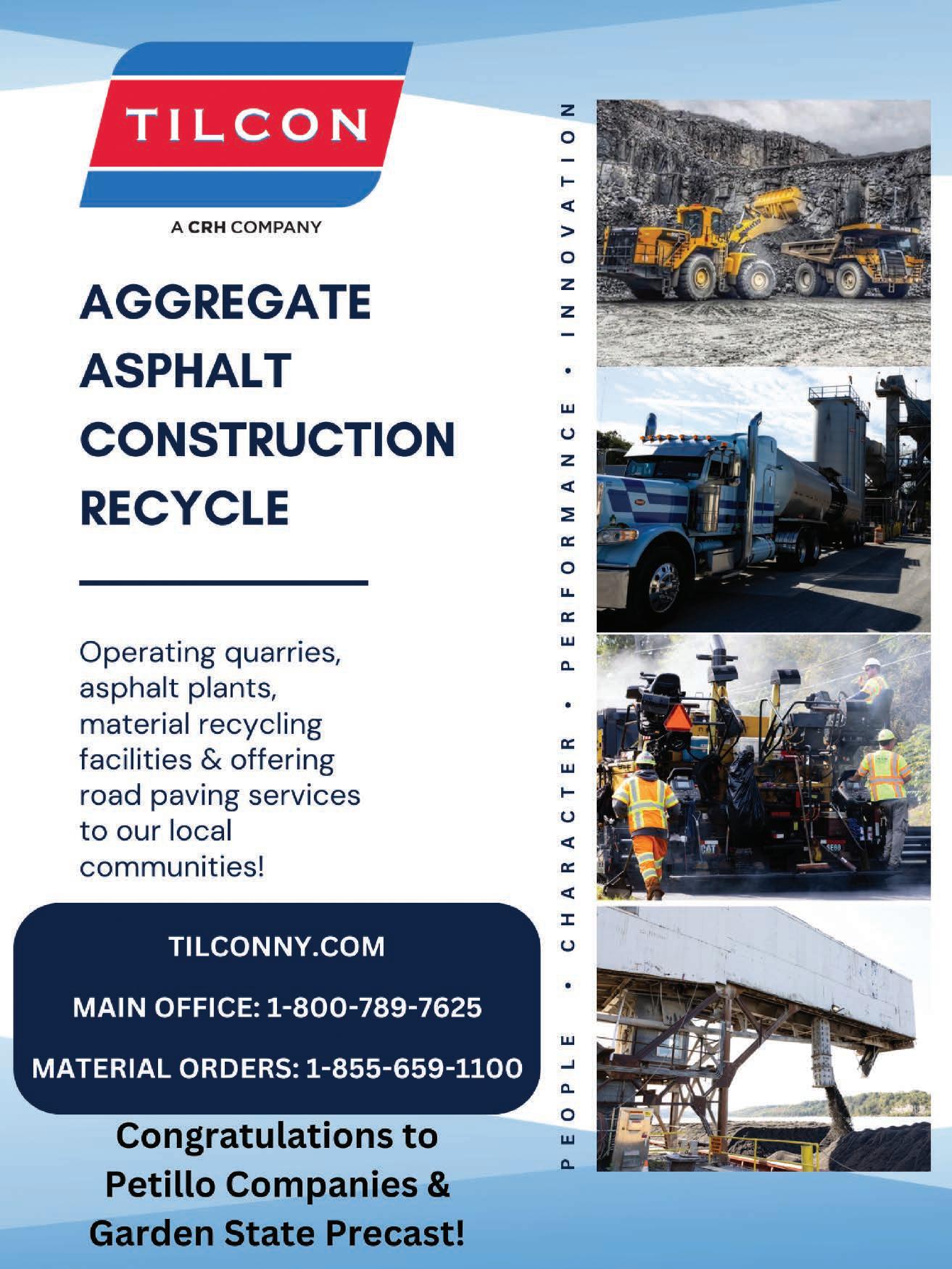








In my last President’s Message, I was touting the many accomplishments and various areas in which the UTCA and its dedicated staff have played a key role. Since that time, UTCA has continued to engage in a number of efforts designed to benefit our Association and the industry.
As I noted in the April magazine, UTCA played a vital role in securing legislative approval of a measure to re-authorize our Transportation Trust Fund. Since then, that legislation was signed into law by Governor Murphy. Because of their efforts, UTCA was invited to the bill signing ceremony where both Bob Briant and Dave Rible were recognized in remarks from the Governor and Assembly Speaker.
Speaking of the Legislature, policy makers in Trenton continue to keep our UTCA team busy, taking up legislation on clean energy, surety bonds, plastic pollution, occupational heat standards and gender and racial disparities in state contracting. In some good news, UTCA is part of a coalition that was successfully lobbying for legislation that was recently introduced to allocate $100 million for municipal water infrastructure planning and design grants.
UTCA has also been busy planning and executing a number of events giving members multiple avenues to participate in Association activities. In April, more than 100 shooting enthusiasts took part in the Scholarship Clay Shoot at Lehigh Valley Sporting Clays. A few days later, the golfers in the bunch were able to show off their skills at the Top Golf Event in Edison which was hosted by UTCA’s Emerging Leaders Committee.
ers, federal issues have also been in the forefront over the past few months. In April UTCA Executive Director David Rible and Government Affairs Director Ryan Sharpe travelled to Washington, DC to take part in the Water Environment Federation's National Water Policy Fly-In. While in the Capital, UTCA hosted a virtual meeting of the Clean Water Construction Coalition which focused on securing additional resources for clean water projects.
A few weeks later, Dave and Ryan were back in Washington to take part in the ARTBA Federal Issues Fly-In where a number of federal issues affecting our industry were discussed. Chief among those issues are proposed rules governing the “Build America, Buy America” program and a new federal OSHA Heat Standard.

Of course, the most talked-about UTCA event was the annual Executive Seminar in which over 90 attendees took in the amazing sights and incredible culture of Ireland while also enjoying informative presentations on issues facing the New Jersey construction industry, including Disadvantaged Business Enterprise (DBE) programs and environmental laws and regulations.
While we continue to keep a close eye on New Jersey lawmak-
After receiving input from many contractors, staff submitted comments on the New Jersey Turnpike Authority’s “Pre-Qualification” rule proposal, and we anticipate the majority of our suggestions will be adopted in the final rule.
Promoting safety remains one of the priorities of the Association which highlighted both National Work Zone Safety Week and Mental Health Awareness Month which takes place each May. Of course, I would be remiss if I didn’t take a moment to acknowledge the tragic accident that led to the collapse of Baltimore’s Francis Scott Key Bridge which provides a stark illustration of the key role infrastructure plays in our lives.
Finally, I would like to offer my congratulations to Michael Petillo and the entire team at Petillo Companies who are celebrating their 30th year in business. Surviving and thriving for 30 years in the construction industry is quite an accomplishment and I look forward to what the future has in store for Petillo. Congratulations also to Garden State Precast on its 25th anniversary.
Gerard L.
Burdi


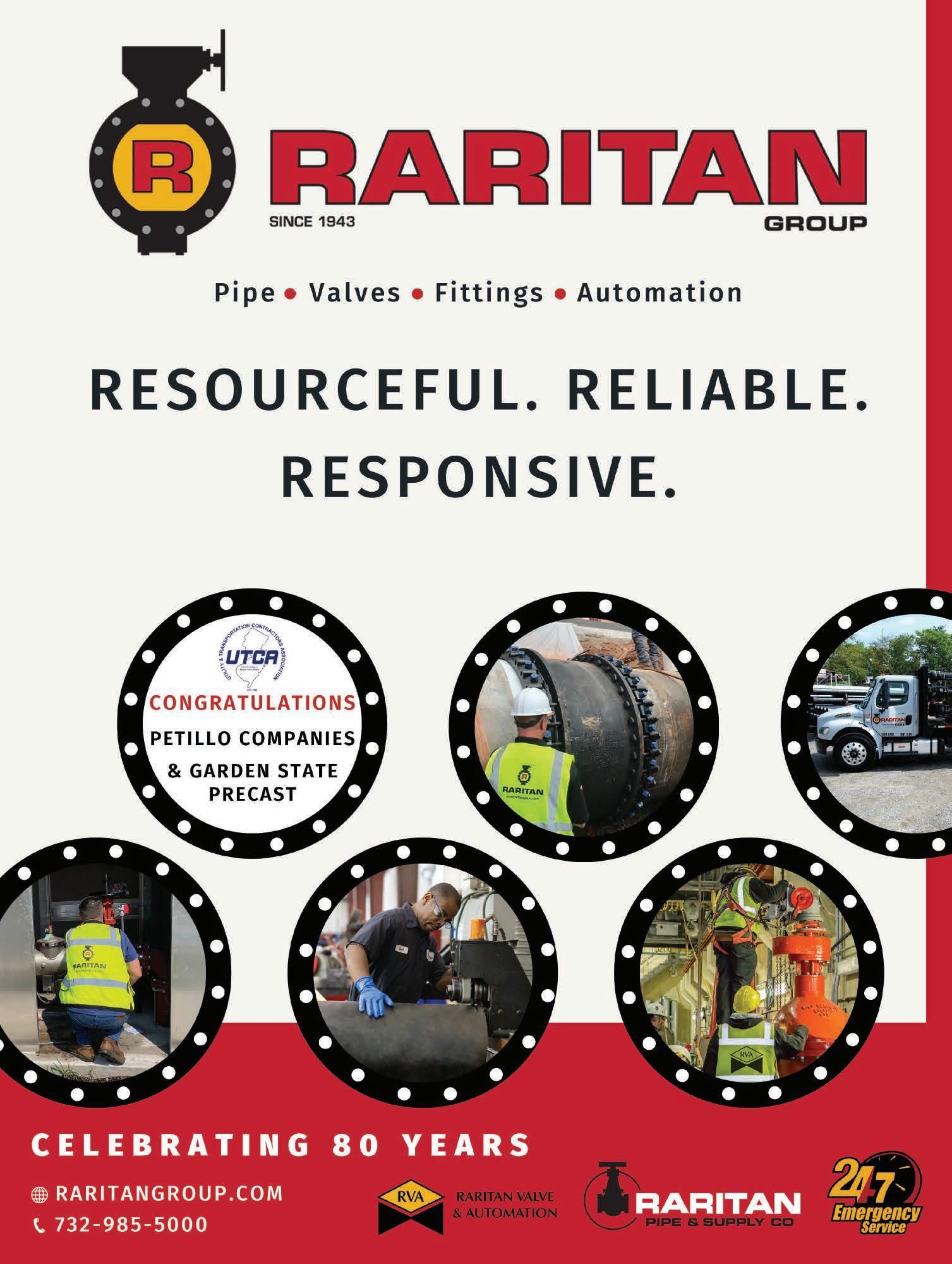


by: Michael h. meyers, partner, mountain hill investment partners
We’ve been on the road lately visiting corporate 401(k) clients and holding group education meetings for their employees. We have several different formats for these meetings but some of the most impactful conversations we have, in my view, are during our age-based meetings. Getting a group of like-minded people together who are relatively close in age allows us to tailor our advice and educate them on what they should be considering at this point in their lives, what challenges potentially lie ahead, and how best to plan for them. It's never too early to start planning for retirement; it’s a lifelong journey that evolves as you progress through different stages of life. As you get older, your strategy needs to be adjusted to reflect changes in your financial situation, goals, and priorities. Let’s examine some important items to consider and actions you can take as you make your way on this journey.
In Your 30s: Building a Foundation
Your 30s are a time of significant financial transition, marked by career advancement, increased earning potential, and potentially major life events such as marriage, homeownership, and starting a family. As you navigate these milestones, it's essential to prioritize saving for retirement to build a solid foundation for your future.
1. Start Early: Time is your most valuable asset when it comes to saving for retirement. The earlier you start, the more time your investments have to grow through the power of compounding. Even small contributions made in your 30s can have a significant impact on your retirement savings over time.
2. Maximize Employer Matches: A 10% 401(k) savings rate should be your goal, but if that’s not feasible early on, contribute at least enough to receive the maximum employer match, this is free money and an immediate return on your investment!
3. Utilize the Roth 401(k): For younger participants in lower tax brackets, the Roth is generally an easy decision to make. The main difference between the Roth and the traditional 401(k) is the tax treatment of the contribution. Roth contributions are made with after tax dollars, and offer taxfree growth and withdrawals in retirement, providing valuable diversification later in life.
4. Invest for the Long Game: You have a long time before retirement which means you can worry very little, if at all, about short term financial market. Stay invested and understand that market corrections at this age are opportunities.
5. Avoid Lifestyle Inflation: As your income increases in your 30s, resist the temptation to inflate your lifestyle proportionally. Instead, allocate a portion of salary increases or bonuses toward increasing your retirement contributions.
In Your 40s: Mid-Career Focus
Your 40s are often characterized by increased financial responsibilities: mortgage payments, college savings for children, home renovations, etc. Despite these competing priorities, it's crucial to stay focused on saving for retirement.
1. Assess Your Retirement Goals: Take time to revisit your retirement goals and assess whether you're on track to meet them. Consider factors such as your desired retirement age, lifestyle preferences, and estimated retirement expenses.
2. Increase Savings Rate: Aim to increase your retirement savings rate as your financial situation allows. If you haven’t hit the 10% 401(k) savings goal yet, examine closely how you can reach that. Look for opportunities to cut expenses or increase income to free up additional funds for retirement contributions.
3. Emergency Funds: While this is a top financial priority at any age, a well-stocked emergency fund is especially important in the peak earning years, when there can be more at stake financially and you’re responsible for more people than in earlier years. There should be enough in the fund to cover living expenses for at least three to six months. Having a cushion that lasts up to a year is ideal and will help you avoid borrowing against retirement assets to cover unforeseen expenses.
4. Explore Retirement Income Options: Start exploring potential sources of retirement income, such as Social Security benefits, rental income, and other investments. Consider how these income streams will supplement your savings in retirement and factor them into your retirement planning.
5. Draw up or Revisit a Will: A will ensures that your assets are appropriately distributed based on your wishes. They re-
quire updates as time passes so spend time to review it now.
Your 50s represent the final countdown to retirement, making it a critical time to fine-tune your strategy and make any necessary adjustments.
1. Reassess Your Retirement Timeline: Confirm your desired retirement age and ensure your financial plan aligns with it. Consider whether you need to make adjustments to your retirement date based on your financial situation and lifestyle preferences.
2. Maximize Catch-Up Contributions: Take full advantage of catch-up contributions available to individuals aged 50 and older. These additional contributions can help boost your retirement savings in the years leading up to retirement.
3. Consolidate Retirement Accounts: Review your retirement accounts and consolidate where you can. If you've changed jobs three or four times by this time in your life, you may have three or more accounts to monitor. Keeping an eye on all those separate accounts is time you could spend doing something else; it could also prove cumbersome for your family if something should happen to you.
4. Get Your Debt in Order: When you retire and begin to rely on your savings, you’ll want to have minimal debt; if you're 50 and still have debt, focus on eliminating that as quickly as possible.
5. Explore Social Security and Healthcare Options: You’ll want to know how much income you can expect from Social Security in retirement. Go to their website and create an account to see how much you can expect based on when you plan to retire. Research your healthcare options in retirement, including Medicare eligibility, supplemental insurance plans, and healthcare savings accounts.
My firm works as an advisor and co-fiduciary to corporate 401(k) plans, specializing in the construction industry. We work with many UTCA member firms to enhance their 401(k) offering by vetting service providers, lowering costs, and building education programs. Planning for retirement is a lifelong journey; make sure your employees have the tools and educational resources to foster great outcomes.
Contact me, Mike Meyers, at (732) 291-3338 or mikemeyers@ mhipartners.com for more information and to schedule a 401(k) plan review.



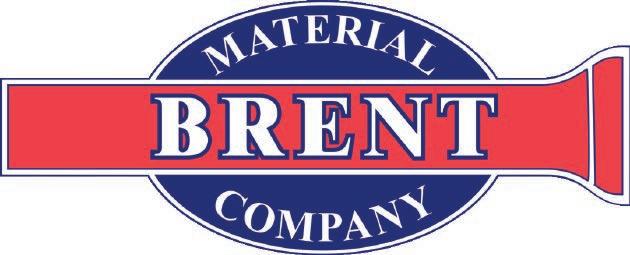
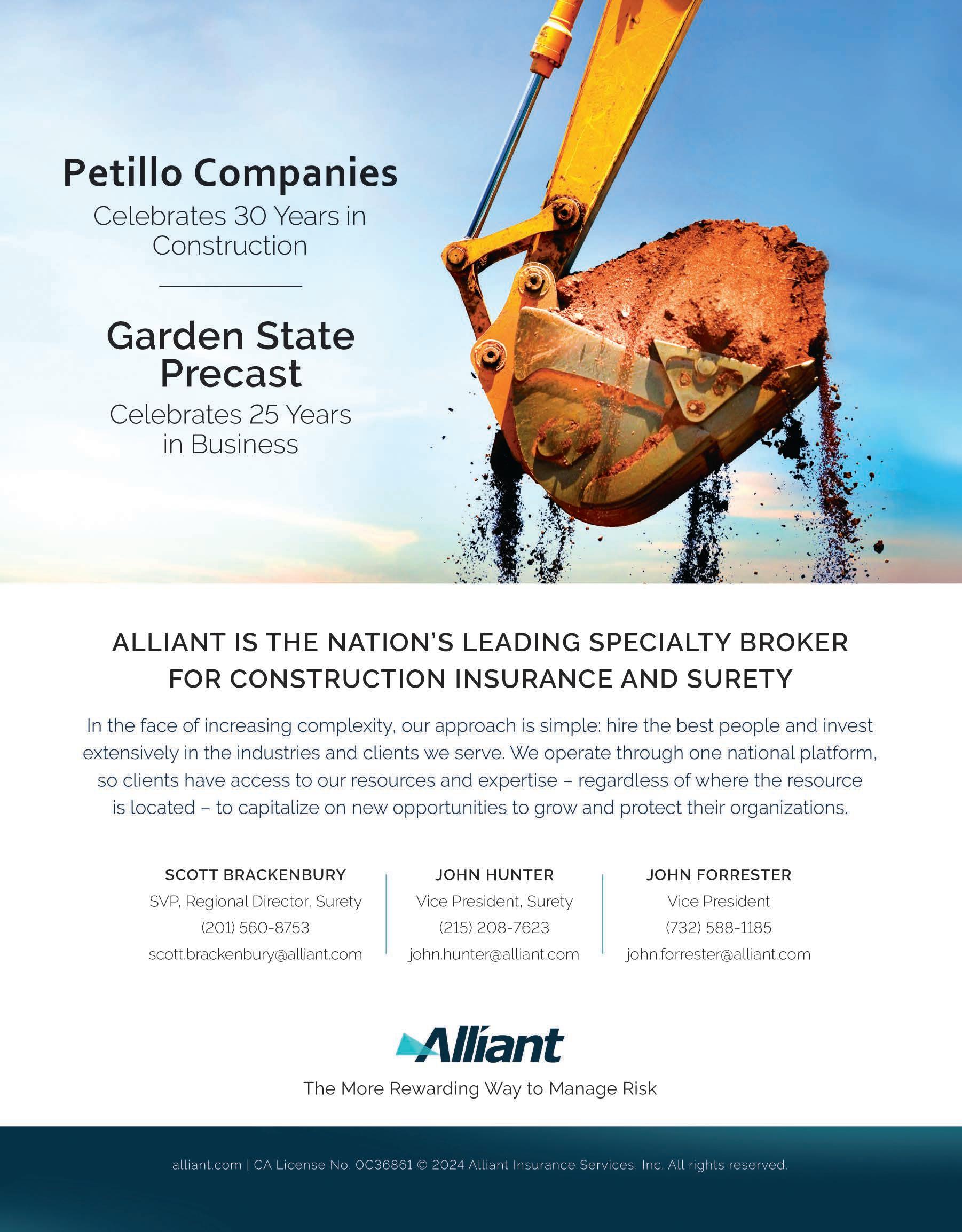






By: nicholas a. sullivan, esq.
The System for Award Management (“SAM”) is a federal government-wide portal used for consolidating the capabilities of multiple systems and information sources used by the Federal government for contractors to do business with the Federal government, including competing for federal procurement contracts.
Pursuant to the Federal Acquisition Regulations (“FAR”) provision 52.204-7, a contractor is required to strictly maintain its SAM registrations to maintain eligibility for all federal procurement contracts. Under FAR 52.204-7(b)(1), a contractor “is required to be registered in SAM when submitting an offer or quotation and shall continue to be registered until time of award, during performance and through final payment of any contract, basic agreement, basic ordering agreement, or blanket purchasing agreement resulting from this solicitation.”
Recently, the U.S. Government Accountability Office (“GAO”) reviewed a bid protest where the protestor argued the awarded bidder failed to maintain its SAM registration for approximately 24 hours, negating the award of the contract.
On August 7, 2023, the U.S. Navy issued an RFP to procure custodial services at the Naval Surfaces Warfare Center in Maryland. Among other provisions, the RFP explicitly incorporated the FARs and FAR 52.204.7. As part of the evaluation criteria within the RFP, prospective contractors were informed that each must comply with all material aspects of the solicitation, including all regulatory requirements.
The Navy received six proposals in response to the RFP. On November 27, 2023, the Navy found that Silas Frazier Realty, LLC’s (“SFR”) SAM was active until December 11, 2023. On December 19, 2023, the Navy finalized its evaluation and determined SFR’s proposal was technically acceptable and was the lowest price. Again, the Navy reviewed SFR’s SAM and found it was active as of December 12, 2023. On December 26, 2023, the Navy awarded the contract to SFR and the second lowest bidder, TLS Joint Venture, LLC filed its bid protest with the GAO.
As part of its bid protest, TLS argued the Navy unreasonably selected SFR because SFR’s SAM registration has lapsed in violation of the RFP and FAR 52.204-7. TLS Argued FAR 52.204-7 required an offeror for a contract to be continuously registered with SAM from the submission of its proposal, trough contract award, and until final payment. In response, the Navy argued that FAR provision 52.204-7 did not impose such a requirement to maintain a SAM registration between close of the solicitation and award of
the contract.
After interpreting FAR 52.204-7 to require a prospective contractor to maintain its SAM registration when submitting an offer, until time of award, and during the performance of the contract until final payment, the GAO disagreed with the findings of the Navy. As such, the GAO reviewed the SAM profile of SFR. The GAO found that on November 27, 2023, the SAM profile for SFR had an expiration date of December 11, 2023. The GAO found that on December 21, 2023, the SFR SAM profile had an activation date of December 12, 2023. Due to the profiles being unclear, the GAO requested the General Services Administration (“GSA”), the administration that manages the SAM system, provide an explanation of the process for a contractor to obtain SAM registration.
The GSA representative explained that a SAM registration expires within one year of when it was last submitted and to avoid lapses in registration, the GSA sends regular email reminders to contractors to renew their registrations. After a contractor submits its renewed registration, the GSA and other federal agencies, such as the IRS, review and verify the information. Once all of the additional agencies review and finalize the registration, the GSA then processes the registration, and the profile will display an “Active” status.
Therefore, based on the record, and the testimony, the GAO found that SFR did not maintain a continuous registration following the submission of SFR’s bid throughout the evaluation period of the RFPs and the award of the contract. The GAO found that SFR’s SAM registration expired on December 11, 2023, at 9:34 A.M. and the government did not verify SFR’s renewal application until December 12th, when the GSA activated SFR’s SAM profile at 9:48 A.M. on December 12, 2023. As such, the GAO found the award of the contract to SFR was in violation of the Terms of the RFP and FAR 52.204-7 and that due to the failure of SFR to comply with the RFP requirements, TLS had a substantial chance for award of the contract. The GAO recommended the Navy terminate the agreement with SFR, make a new selection for award of the contract, and pay the filing and protest fees to TLS.
As demonstrated by this GAO decision, it is crucial for a contractor to stay up to date on its SAM registration. The SAM registration process requires both action by the contractor and the government, with the latter involving interaction between multiple agencies to review and grant approval. This can cause a delay in maintaining an active SAM registration. As demonstrated in this matter, a 24 hour lapse in SAM registration will cause a contractor to miss out on an award of a federally procured contract.






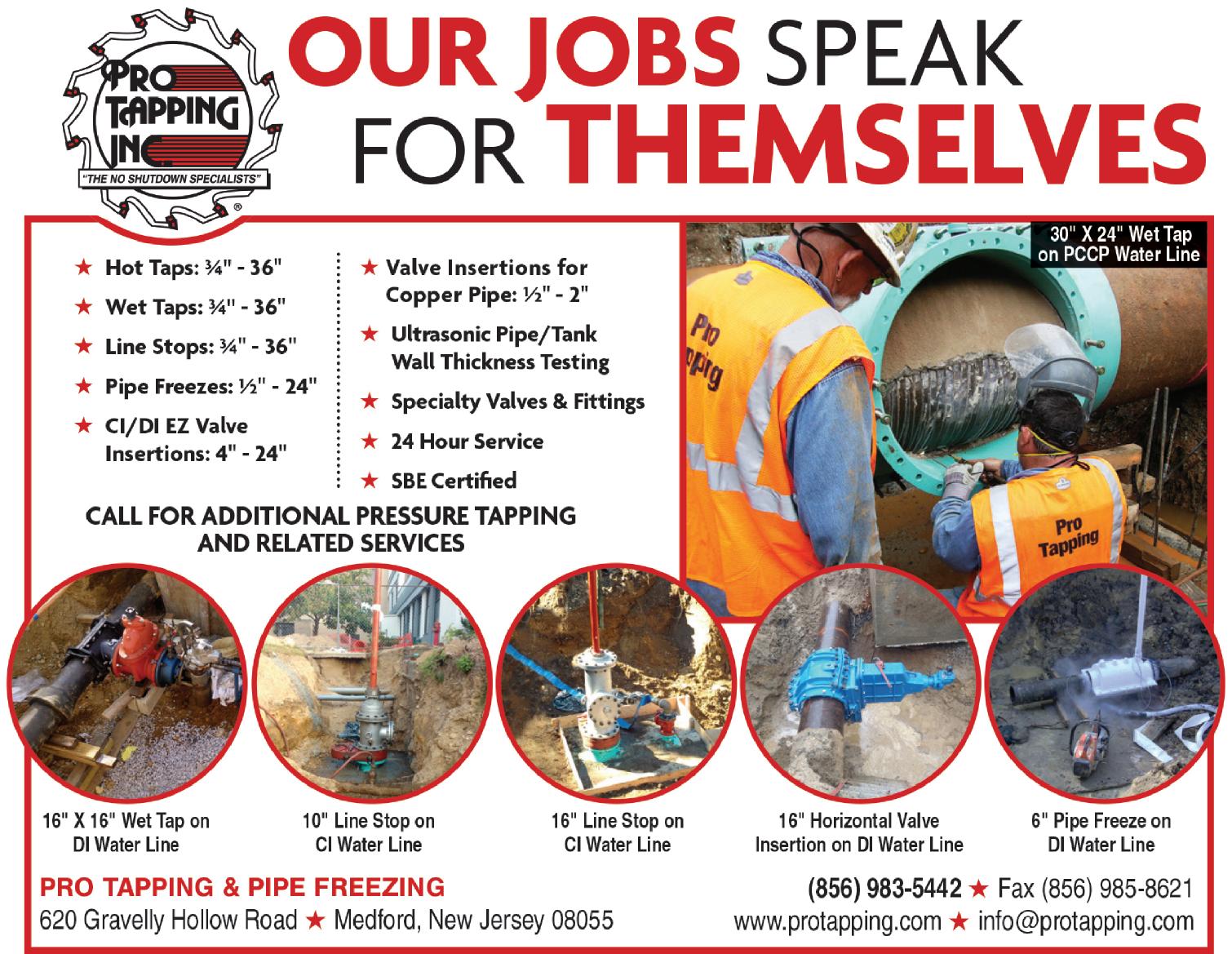


By: matthew trubenbach-byrne, cpa, ccifp | withum
CECL is effective for private companies for fiscal years beginning after December 15, 2022. Companies across the construction industry would have seen a current year change with respect to their accounting for the allowance for credit losses, previously known as the allowance for doubtful accounts. While this standard was not written specifically with construction contractors in mind, the impact stretches beyond what follows the words “allowance for” in a company’s financial statements.
As opposed to the previous accounting treatment wherein a company would wait for losses to be “probable” prior to recording a reserve, CECL standards require a more in-depth estimation of amounts that are more likely to become uncollectible in the future. Gone are the days where companies can rely solely on historical data and established policies; with the requirement to estimate the potential for lack of collectability requiring an additional requirement to “look forward” and put heavier reliance on forecasts and economic conditions which will yield the need to be more critical of inputs.
Unlike the recent revenue recognition and lease standards that required more up-front analysis and minimal recurring adjustments, CECL will require a more hands-on and active approach toward its accounting and estimation on an annual basis. Although historical data such as write-off rates specific to the company, its industry and customer base should continue to be a factor in a credit loss analysis, more inputs will be needed to properly comply with CECL. Companies should be reviewing the economic outlook of their specific industry as well as other factors when considering the need for a larger or smaller allowance including considerations as:
• Have you increased or decreased the number of contracts that are bonded or with a governmental agency? - While many utility and transportation contractors are working on these types of projects where there are little or no credit loss concerns due to near guaranteed payments once billings are approved, a deviation towards more private or unbonded contracts will yield a more in-depth review of the potential for credit losses as these contracts carry a larger risk for credit losses.
• Will the current interest rates or inflation rates impact your receivables? - With the continued above average rates of inflation and the Federal Reserve Board’s May announcement to hold steady with interest rates, are there chances that your
customer base might not have sufficient cash flows to pay balances due? Would this opinion change if the Fed reduced rates as a result of the June meeting or if the Bureau of Labor statistics noted even higher inflation?
• Could the Paycheck Protection Program or the Employee Retention Credit have helped your customers pay down receivables in the past several years, inflating the rate of collection used as a means for your allowance? – As noted above, utilizing historical data can be a great means for benchmarking the number of current contracts and balances that might not be collectible. However, recent trends might be skewed by these large cash influxes that would have assisted struggling companies with paying vendors in a timely manner. Could there be any vendors who will have continued cash flow issues without this government assistance?
• What does the overall financial market look like? - You might not be part of the S&P 500, but the performance of blue-chip stocks are often indicators of how the overall economy is performing. Any significant swings, whether upward or downward, could be indicative of larger economic changes.
• Are there any customers that are showing indications of financial difficulties either before or after your reporting date? – Even if a customer balance was current at your reporting date, has that balance been paid by the time you issue your report potentially several months later? Even if still currently considered collectible, are there indications that something could be wrong, and this balance could go unpaid?
Even though all the above and more should have been considered when performing 2023 financial reporting, it is important to note that these inputs and factors should be monitored on an ongoing basis and the allowance for credit losses adjusted as needed. This should come in the form of a documented annual analysis that lists all relevant factors considered and the ultimate estimated allowance for credit losses that has been recorded.
From a practicality standpoint, most contractors are already performing these types of analysis as part of the regular course of operations and are often doing so well before the asset subjected to CECL is generated. The above may seem daunting and significantly more time consuming than what has been done historically; however, CECL’s application with respect to utility and transportation contractors is not appearing to have significant impacts on the industry. In the end, this could all just be another item that us auditors get to bother our clients for.







President’s Club
J. Fletcher Creamer & Son
D’Annunzio & Sons
George Harms Construction
Northeast Remsco
Union Paving & Construction
Governor’s Level
Black Rock Enterprises
JRCRUZ Corp.
Montana Construction
P&A Construction
Petillo LLC
Schifano Construction
Skoda Contracting
Ambassador Level
Asphalt Paving Systems
South State Inc.
Leadership Level
Ralph Clayton & Sons
Kiely Civil
R.E. Pierson Construction
Traffic Lines Inc.
Platinum Level
Anselmi & DeCicco
B. Anthony Construction
Bayshore Recycling
Diaco Contracting
Haines & Kibblehouse Inc.
M.S.P. Construction Corp.
New Prince Concrete Construction
Orchard Holdings
P.M. Construction
Pillari Brothers Construction
Pioneer Pipe Contractors
M.L. Ruberton Construction
Smith Sondy Asphalt Construction
Work Zone Contractors
Yonkers Contracting
Gold Level
C&H Agency
Eastern Landscape Contractors
Lehigh Utility Association
Mathis Construction
Metra Industries
Northwest Equipment
Penn Bower Inc.
Persistent Construction
Sa & Sons Construction
Silver Level
C. Abbonizio Contractors
JA Alexander
Atlantic Cordage
Bil Jim Construction
Brent Material
CATS Sweeping
CRS Contractors
Caterina Supply
Concrete Construction Corp.
Concrete Cutting Systems
Edward H. Cray
Flanagans Contracting
J.C. MacElroy Co.
Pro Tapping
Ritacco Construction
Rockborn Trucking & Excavation
SJA Construction
Scafar Contracting
V.A. Spatz & Sons
TKT Construction
Taylor Oil Company
Tobia & Lovelace
Trench Technologies
Zack Painting

By: ryan sharpe, director of government affairs and communications
April’s edition of Legislative News opened with great news for the infrastructure construction industry with the enactment of the law re-authorizing New Jersey’s Transportation Trust Fund which funds transportation infrastructure projects across the state.
Unfortunately, that news was quickly overshadowed by the tragic collapse of Baltimore’s Key Bridge which resulted in the loss of the lives of six construction workers. In addition to these tragic deaths, this accident will also have a major economic impact on the region and country by limiting access to one of the busiest ports in the nation.
While these financial concerns pale in comparison to the loss of human lives, the collapse of this key transportation structure highlights both the importance of our transportation infrastructure and the dangers faced by those who work in our industry.
On a lighter note, here in New Jersey, the Legislature has entered the period known as “budget break” where most legislative action takes a backseat to the respective Budget Committees which are tasked with reviewing the Governor’s proposed budget announced in February. The Committees will hear testimony from policymakers, stakeholders and the public in a series of hearings before ultimately approving a Budget by the June 30 deadline. The final product could match the Governor’s proposal or contain changes desired by the Legislature.
A key part of these deliberations will likely be focused on the Governor’s proposed Corporate Transit Fee which would raise taxes on companies making more than $10 million with the over $800 million in revenue raised by this tax dedicated to NJ Transit. This is particularly important because NJ Transit is facing a deficit of about $900 million in the next fiscal year.
Another issue recently taken up by lawmakers is plastic pollution. Recently, the Senate and Assembly Environment Committees held a joint hearing on plastic pollution and its effects on human health and the environment. While the Committee did not vote on any bills at this meeting, it is likely this meeting will result in legislation related to this issue.
Another bill that could affect the industry by changing laws regarding surety bonds was considered by an Assembly Committee in March. Under A-3943, when responsibility for completing a transportation project has been assigned to a surety company, the surety would be required to enter into a contract with

a contractor within 60 days and the contractor would have to begin or resume construction within 60 days of executing the contract. Violations of these provisions would result in a fine on the surety of at least $10,000 a day.
UTCA has serious concerns with this measure and has been working with the bill sponsor and a coalition of insurance and surety companies to seek amendments to mitigate the impact on the industry. We are hopeful the legislation will reflect our suggested amendments when this bill is taken up in a future Committee meeting.
We have also been engaging with lawmakers on a measure that would set an occupational heat standard in New Jersey and impose multiple requirements on employers when the temperature reaches 80 degrees. In light of the impact these policies would have on the construction industry, UTCA opposed this bill and has requested it be amended to exempt public works construction projects.
Another issue that has been in the news is per- and polyfluoroalkyl substances, which are more commonly known as PFAS. These chemicals, which take years to break down, are sometimes referred to as “forever chemicals” and are used in a wide variety of consumer and industrial products. PFAS have been found in soil, air, fish and water across the world and concerns over the potential human health risks of exposure to these chemicals has caused several states, including New Jersey, to set maximum PFAS levels for drinking water.
Recently, the EPA issued national PFAS drinking water standards which are more stringent than New Jerey’s limits and give water systems three years to monitor the water and five years to implement solutions if the system is found to exceed PFAS levels. According to some estimates, complying with these rules will cost water systems around the country upwards of $3.8 billion a year.
Interestingly enough, when this rule was released, UTCA was in Washington to participate in the National Water Week Flyin. This meeting offered our association a great opportunity to meet with key policy makers and other stakeholders about the critical need to invest in water infrastructure. During the Fly-in, UTCA led a meeting of the Clean Water Construction Coalition (CWCC) which focused on federal water funding, the political
landscape in Washington and various other issues affecting water projects across the country.
In fact, one of the issues discussed at the CWCC meeting was the “Build America-Buy American” or “BABA” requirements which were expanded by the Infrastructure Investment & Jobs Act (IIJA). Under BABA, products and materials used on federally funded infrastructure projects must be produced or sourced in the United States or consist of mostly American-made components.
While these requirements predate the IIJA, the implementation of these requirements has caused tremendous confusion about how contractors and suppliers will comply with these complicated and, in some instances, completely unworkable rules. In fact, UTCA members have indicated that they have been asked to submit documentation to attest that they are in compliance with these rules.
Of course, any legislative update would not be complete without noting the ever-changing political landscape that helps shape these and other policies affecting our industry. With Senator Bob Menendez fighting federal corruption charges, the fight to fill his US Senate seat took a dramatic turn when Governor Murphy’s wife dropped out of the race, leaving Congressman Andy Kim as the overwhelming favorite to become New Jersey’s next Senator.
One of the most significant developments of this race was a court decision that struck down the use of the “county line” in elections. In this system, which is unique to New Jersey, candidates who gain the approval of a county’s political party organization receive preferential placement on the ballot which gives them a substantial advantage on election day. The effects of this ruling are still being determined but will likely have a significant impact on the influence of county political parties and political bosses.
As this drama around “the line” unfolds, a growing number of politicians are joining a large group of candidates for New Jersey Governor in 2025. Most recently, 2021 GOP candidate Jack Ciattarelli formally entered the race, joining Republican State Senator Jon Bramnick, former State Senate President Steve Sweeney, Jersey City Mayor Steve Fulop and Newark Mayor Ras Baraka.
At the federal level, the unprecedented dysfunction continues as hard-right Republicans in the House continue to block major policy initiatives and threaten to oust Speaker Mike Johnson. This all is taking place in an election year that could alter which party controls the House and Senate. Of course, this campaign will be heavily influenced by the Presidential rematch between former President Trump and President Biden.
Clearly, this will be another eventful year here in New Jersey and in Washington that UTCA will be watching closely as we continue to advocate for the infrastructure construction industry.









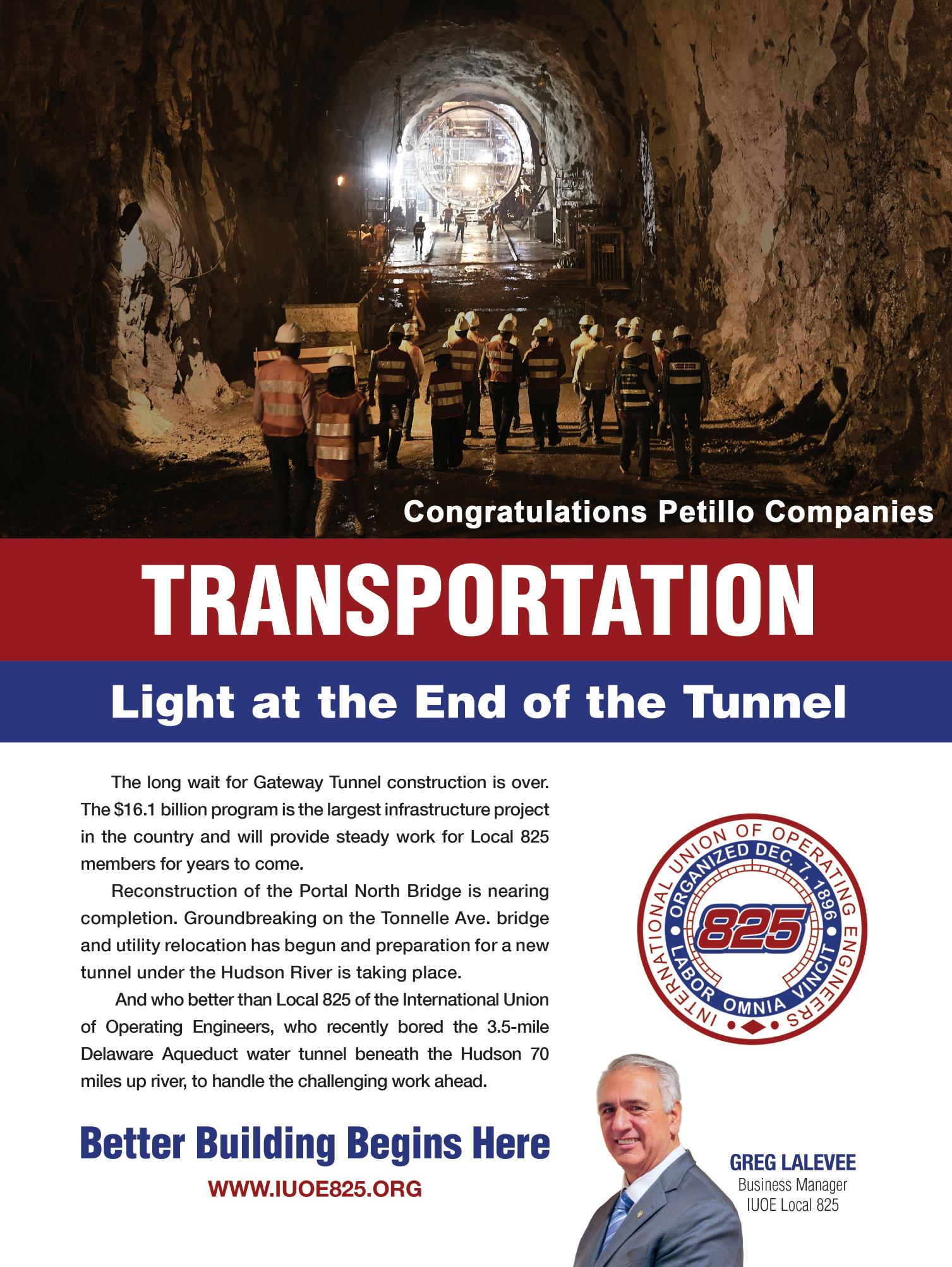

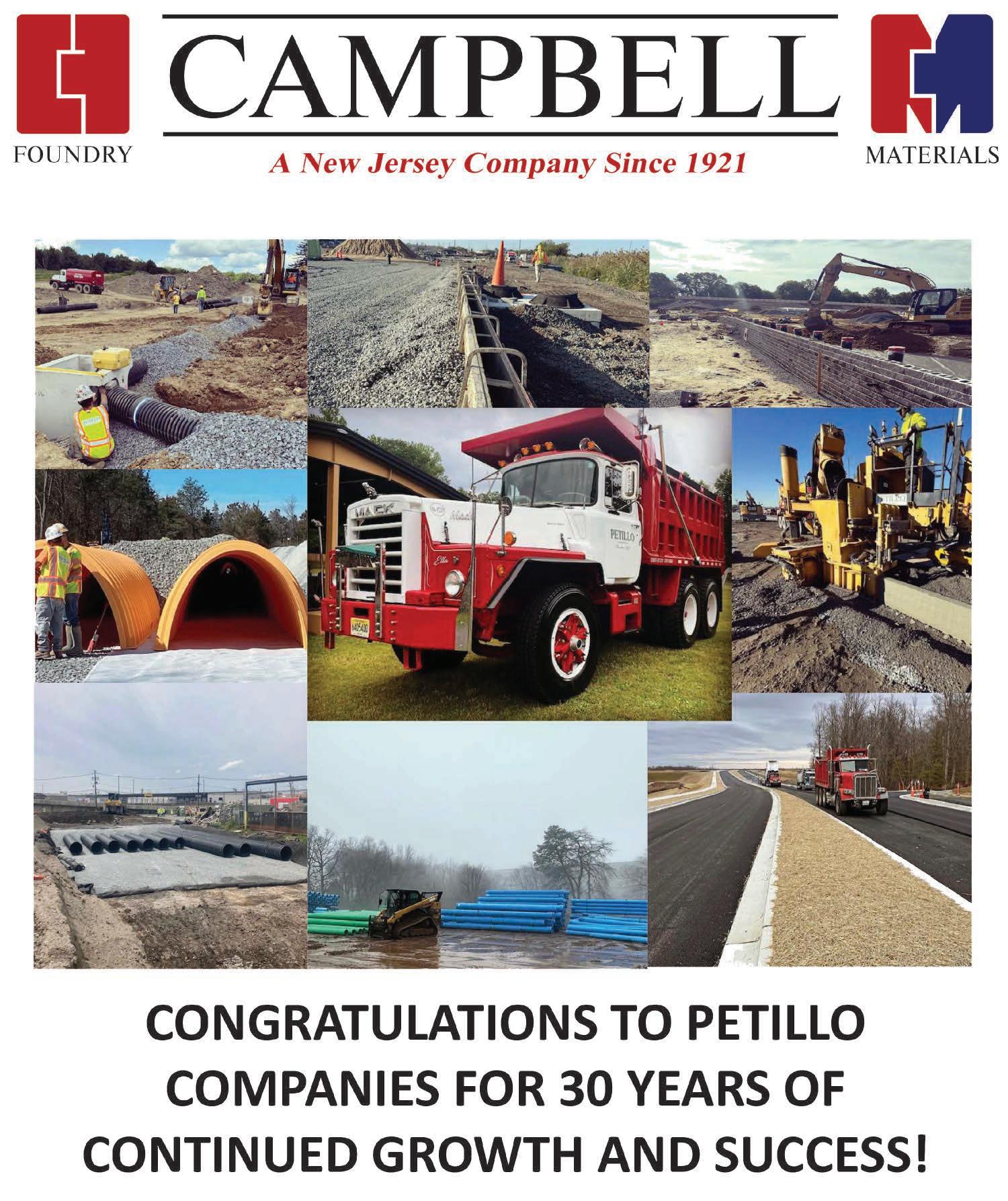


By: Ryan Sharpe Director of Government Affairs and Communications
When you sit down in the conference room of Petillo Companies headquarters in Flanders, your attention is immediately drawn to the large video screens displaying feeds of nearly a dozen locations at the facility. Another screen displays a dashboard that can pinpoint the location of every Petillo crew and piece of equipment working up and down the East Coast. The data this program provides is so precise that users can see the volume of fuel being consumed by a machine being used on a project in Virginia.
The utilization of this state-of-the-art technology is just one of the many unique attributes that have allowed Petillo to achieve incredible success over the past 30 years and have them positioned to continue to grow and thrive for years to come.
Much of the success of the company has been driven by the company’s founder, Michael Petillo, who started out in the land-


scaping industry before founding Petillo in 1994. With about 40 employees and a couple pieces of equipment, the company mainly worked on residential subdivisions, performing excavation, landscaping and road construction.
Soon they expanded their service offerings and embarked on a number of public work projects, including schools and libraries. Petillo then began to expand its offerings to become a full-service construction firm, providing engineering, surveying, site work, utilities, curbs, paving, retaining walls and any other task required to complete a project.
They also started to shift their focus to industrial projects, large earth movement projects, and became heavily involved in the commercial sector.
One of the biggest projects they completed at the time involved capping the Dover Landfill and cutting away a mountain in order to construct a 400,000 square foot FedEx facility. Their list of clients includes a number of retail giants, like Wal Mart and Target.
Soon Petillo was one of the leading contractors in the warehouse construction sector which became a significant part of their portfolio. With the explosion in e-commerce, they quickly moved from single warehouse projects to multiple-building projects and industrial parks.
However, as the warehouse market cooled, they were quick to adapt and shift their focus to new growth areas, like e-infrastructure, which consists primarily of data centers needed to keep up with our increasingly internet-based economy.
Petillo’s ability to adapt to the changing marketplace has helped them achieve unprecedented growth over the last three decades.
They now have nearly 500 people on staff and have expanded their geographic footprint, performing work in New Jersey, New York, Pennsylvania, Maryland, and Virginia. In addition to their New Jersey office, they have also opened offices in Maryland and New York.
One of the projects performed by Petillo is the I-78 Logistics Center which is a 365-acre development located along the Interstate 78 corridor in Lopatcong and Phillipsburg consisting of seven buildings and bridge access. Petillo was responsible for all the site work, including excavation, grading, underground utilities, paving, curbs & sidewalks, and site egress improvements, which included two intersections and reconstructing an access bridge.
Another Petillo project is the 74-acre Arsenal site located in Sayreville which is comprised of three buildings totaling over one million square feet of industrial space. Petillo was responsible for all site work including excavation, grading, underground utilities, paving, curbs & sidewalks, multiple retaining walls and offsite road improvements to Bordentown Road.
Petillo also developed the site for the Matrix Logistics Center in Newburgh, NY which involved blasting and processing 880,000 cubic yards of rock, installation of all underground utilities, retaining wall construction, exterior concrete work and all hardscape and landscaping, and also included road widening and traffic signal installation.
The team at Petillo attributes its success to many factors, but all agree it begins with the culture established by CEO and Founder Michael Petillo and what is referred to as the “Petillo Way”. The son of a Marine Corps veteran, Mike immediately instilled the discipline that drives every aspect of the company. This mindset is both a business model and a culture.
Discipline is the key to their business model in which every project runs the same way, no matter what type of work or where the project is located. When a plan is developed, both management and field staff work hand-in-hand to ensure the plan is executed.

Another unique facet of their approach is the utilization of “taskbased” crews in which the team assigned to a project has the experience and skillsets designed for that type of work. This means the crew that performs pipe work will be assigned to a pipe project. To ensure each project is successful, this crew is provided with all the support and resources necessary, including equipment and materials.
This system is augmented by an unyielding commitment to ensure the project is done right and on time. Petillo will work seven days a week and holidays to finish on time or ahead of schedule. This efficiency results in cost savings to the owner.

“We are an aggressive, production-based company that is 100% committed to getting the job done right and on schedule,” said Petillo. The “Petillo Way” means we are disciplined and efficient, so we ensure our clients receive superior service for the best price.”
A union company, Petillo also credits much of their success to their staff. They note with pride that they experience very little turnover among their employees, which they believe stems from the family-like atmosphere at the company and their commitment to safety.
“We cultivate a safe, family culture,” said General Superintendent Mike Castaldi. “We treat our employees with respect and our employees want to come to work every day.”
They also note that they make a point to celebrate their employees’ accomplishments and many staff members enjoy team-building events and take part in the annual Safety Celebration, which includes both employees and their families.
Of course, the staff would not achieve success without access to the resources to complete projects, including construction equipment. In fact, one of the attributes that makes Petillo stand out in the field is their investment in the equipment side of the business.
They have over 1,500 pieces of equipment and support vehicles which are repaired and maintained in-house by their equipment division which consists of 28 employees. Performing these tasks themselves limits equipment downtime which benefits both the company and the project owner by avoiding delays.
The equipment department is emblematic of Petillo’s mindset of relying on themselves to get the work done. This dedication to self-sufficiency means they have staff to perform every aspect of a project, which allows them to self-perform 90% of all their work. In fact, in addition to having their own welders, painters, mechanics and others with unique expertise, they bring in their own fuel and even have the equipment to crush stone and make their own aggregate on the job site.
Embracing technological advances is also a critical component of managing the 30 or so jobs that Petillo is working on at one time. In addition to utilizing advanced software to estimate and manage projects, they also employ drones to plan and manage their projects.
The team at Petillo is quick to highlight their great relationships with many subcontractors and vendors, including Brent Material, Campbell Foundry, Tilcon, Peerless Concrete, Core and Main, Foley, and H.O. Penn.
Despite their unparalleled success, Petillo refuses to rest on their laurels. In fact, in 2021, the company was purchased by Sterling Infrastructure, a national leader in building, transportation construction and e-infrastructure. Being purchased by this public company increased their buying power and bonding capacity which will allow Petillo to continue to grow. They also note that Sterling has adopted many of the Petillo processes for other components of their business.
Michael Petillo is still running the day-to-day operations at the company and plans to continue to drive Petillo’s success for years to come. In addition, he hopes to ramp up his work with Pillar Continuum of Care, a non-profit that provides support for people with disabilities, where he is the Chair of the Board of Trustees.
As for the future of the company, Petillo will continue to adapt to the changing market conditions, which are often influenced by economic factors like high interest rates. But, as work in one field may slow, another field will often increase. For example, the cooling of the warehouse market has coincided with growth in the construction of data centers. As such Petillo expects to continue its steady growth, especially in the rapidly expanding southern region.
As the industry continues to evolve, Petillo is well-positioned to build on its success by continuing to provide superior services while utilizing the “Petillo Way” to deliver projects efficiently and on time. Congratulations to Petillo on 30 years in business and we look forward to their continued success.






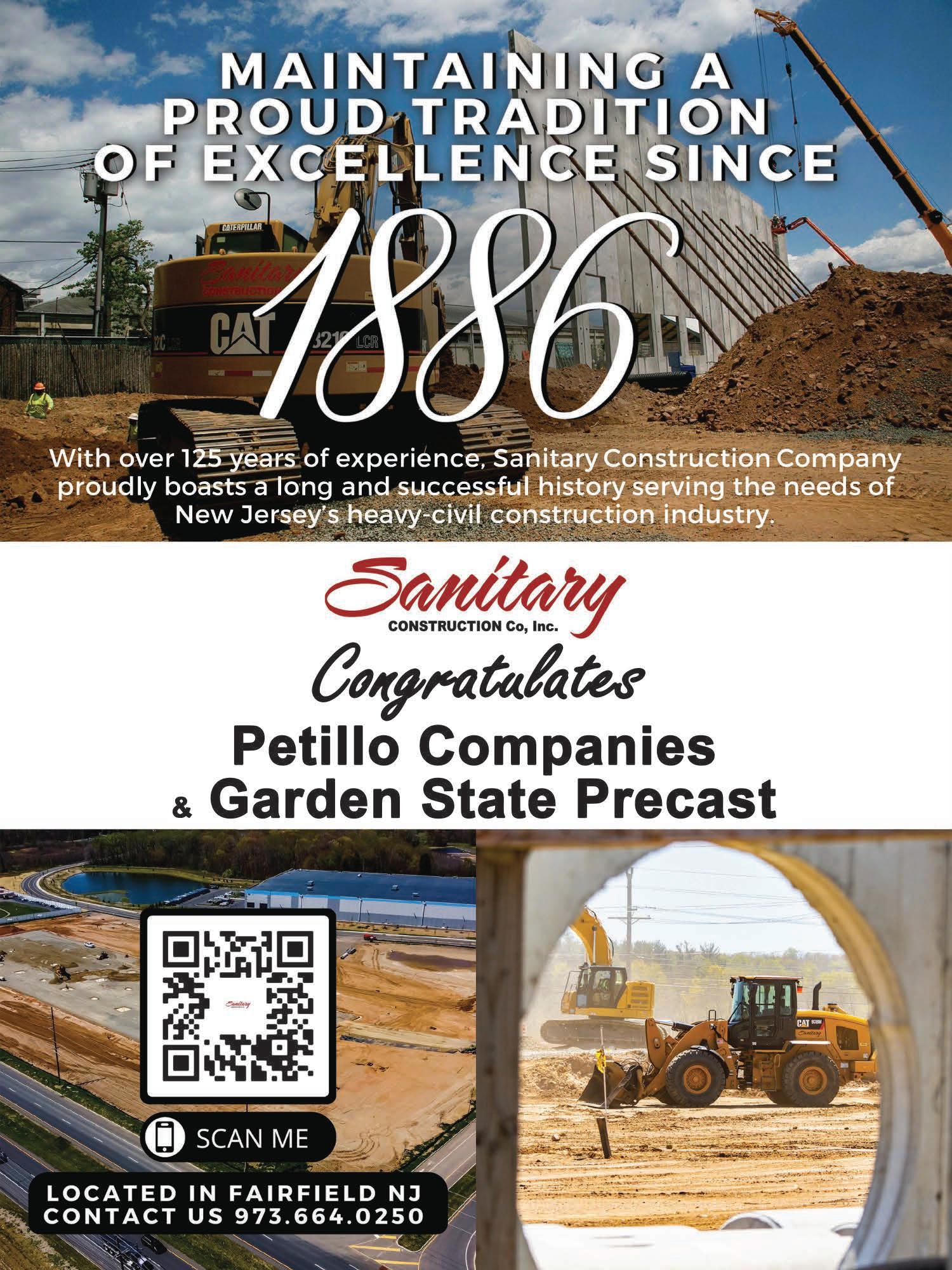




By: kevin Brotspies and greg trif, trif & modugno llc
Presently, approximately twenty percent of United States workers are subject to a non-compete agreement (an agreement, or provision contained within an agreement, that restricts a worker’s ability to compete with his or her current employer after leaving his or her current employment). Under a final rule (“Rule”) approved by the Federal Trade Commission (“FTC”) on April 23, 2024, non-compete agreements will be –with limited exceptions – outlawed nationwide. Barring judicial intervention (as the Rule is already the subject of legal challenges), the Rule will take effect later this year. Employers need to be prepared for the tremendous impact that this Rule will have.
In adopting the Rule, the FTC determined that non-competes are an unfair method of competition and, thus, a violation of the FTC Act. Upon the effective date of the Rule, all existing non-competes for “workers” other than “senior executives” will be invalidated and unenforceable. Thereafter, with limited exception, it will be unlawful for a business to enter into a non-compete with anyone, including a “senior executive.” The term “worker” is broadly defined to include not only employees, but also independent contractors, interns, apprentices, and volunteers. A “senior executive” is defined as a worker: (i) making at least $151,164 in annual salary; and (ii) holding a “policy-making position.” This definition of “senior executive” will typically encompass C-suite executives and officers, among others who satisfy the requirements.
Following the effective date of the Rule, with respect to any worker, other than a “senior executive,” a for-profit business is prohibited from the following: (i) entering or attempting to enter into a non-compete agreement; (ii) enforcing or attempting to enforce a non-compete; and (iii) representing that a worker is subject to a non-compete. Thus, except for “senior executives,” existing non-compete agreements will be unenforceable after the Rule takes effect. Although companies will not be required to formally rescind existing non-compete agreements, they will be required to provide written notice to all non-“senior executive” workers, who are currently subject to a non-compete, that their non-compete agreement is no longer enforceable. Employers should thus start identifying workers who may need to receive such notice under this new Rule.
The FTC views “senior executives” differently than other workers, noting that “senior executives” are more likely to have negotiated the terms of their non-compete agreements and received compensation in return for having agreed to a non-compete.
Accordingly, the Rule is more permissive with respect to existing non-competes with “senior executives.” Existing non-competes with “senior executives” will continue to be enforceable after the Rule takes effect. However, businesses will be precluded from entering into new non-compete agreements with “senior executives” after the effective date of the Rule. Employers may consider entering into non-competes with “senior executives” prior to the effective date of the Rule.
There are other limited circumstances under which a business may enter into, or enforce, a restrictive covenant following the effective date of the Rule. First, employers may continue to prohibit employees from competing during their employment, as the Rule only restricts post-employment non-competes. Second, the Rule does not prohibit contractual provisions that restrict the seller of a business from competing with its former business following the closing of a sale transaction. Third, the Rule exempts litigation that “accrued” before the Rule’s effective date. As such, companies considering enforcing existing non-compete agreements should consider commencing litigation before the Rule takes effect.
Finally, the Rule does not expressly preclude businesses from entering into non-solicitation agreements or confidentiality/trade secret agreements, which safeguard the company’s valuable relationships, sensitive information, and intellectual property. It is expected that these less-burdensome agreements will be principal alternatives to the now-prohibited non-compete agreements.
Without judicial intervention, the end of the non-compete era is rapidly approaching. Employers should prepare now for this very different future by, among other things: (i) identifying existing workers whose non-compete agreements will be invalidated; (ii) identifying “senior executives” with, and without, existing non-competes; and (iii) considering whether to enter into alternative agreements, such as non-solicitation agreements and/or confidentiality agreements, with workers, in lieu of non-compete agreements.
About the Authors . . . Kevin S. Brotspies, a member of Trif & Modugno LLC, represents businesses, including contractors and subcontractors, in all areas affecting the construction industry, including in employment and labor matters. Greg Trif, a member of Trif & Modugno LLC, represents developers, general contractors, subcontractors, and suppliers in all areas of law affecting the construction industry including contract claims, project crisis management, labor and employment disputes, and business torts.



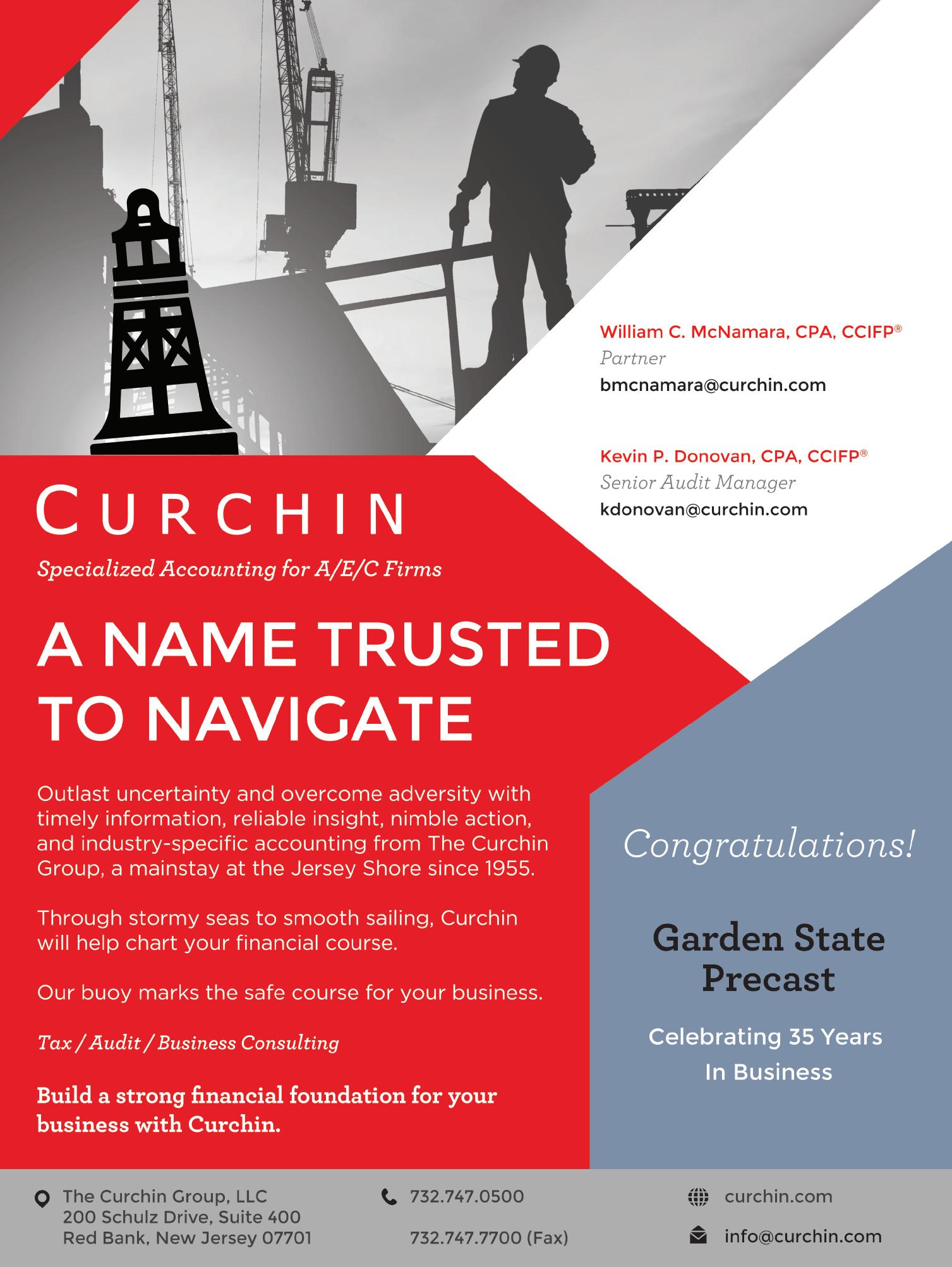
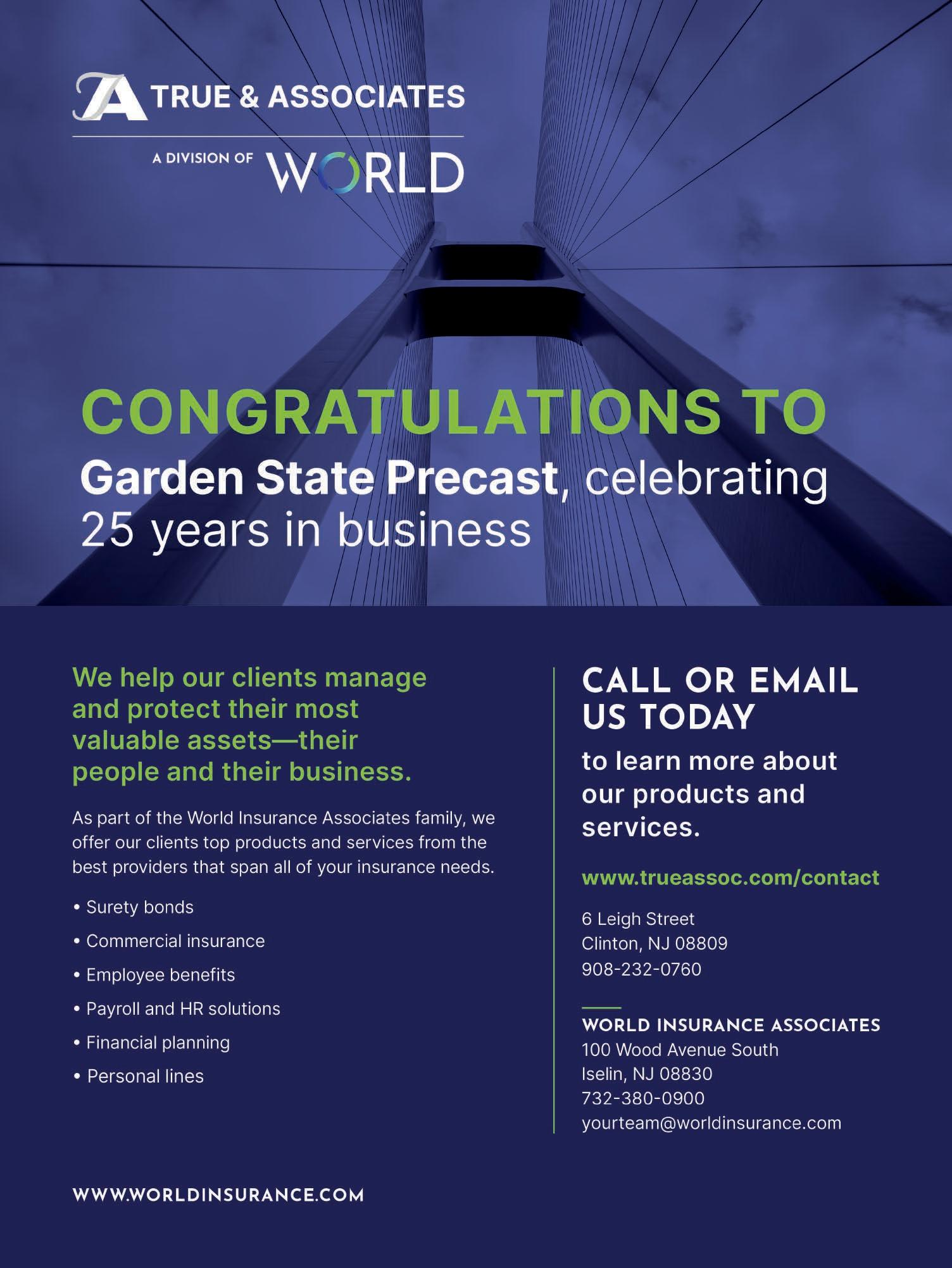

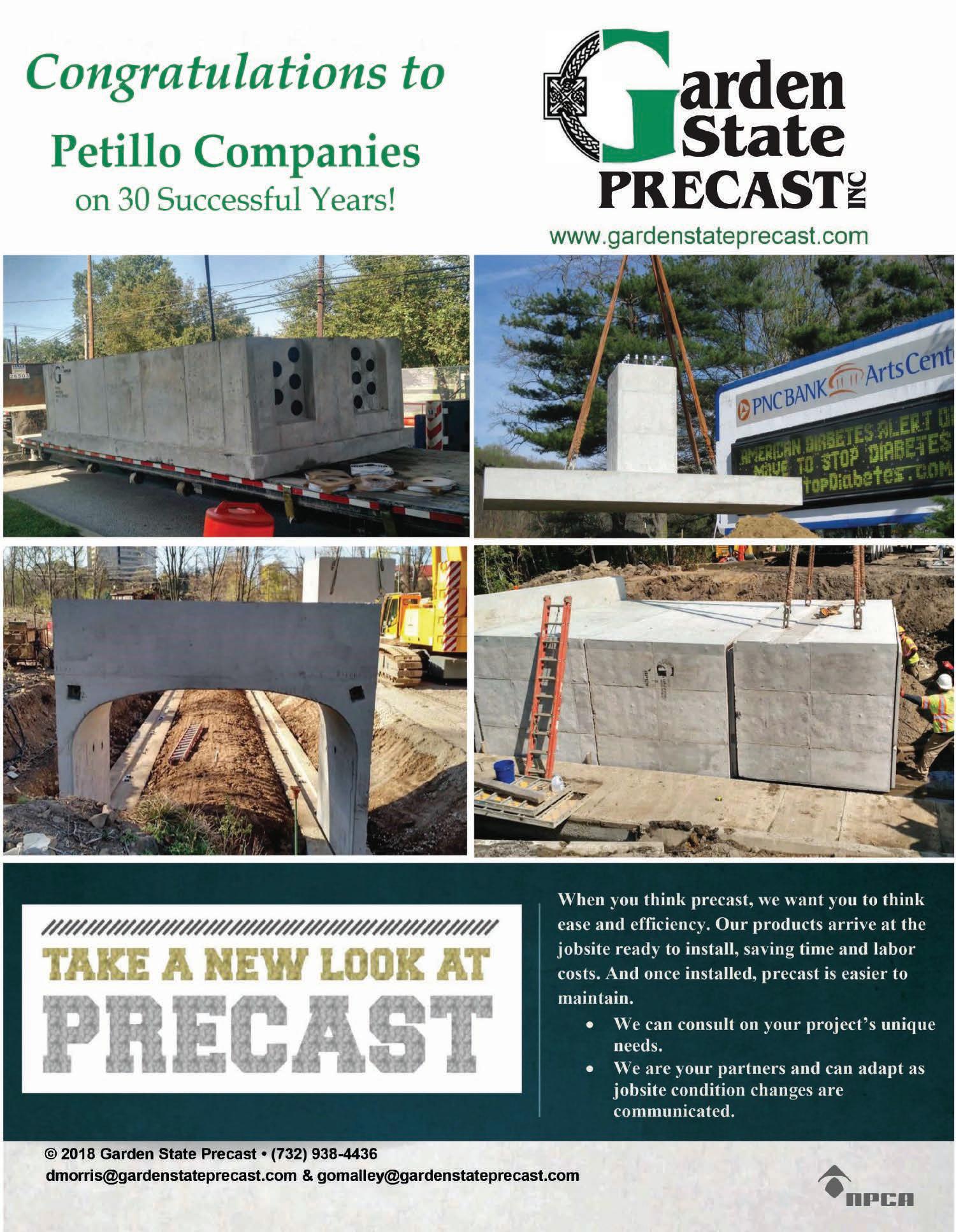
By: Rick Stewart
Garden State Precast, celebrating 25 years of building a concrete foundation with its customers, vendors and employees, is excited about its future as the next generation of family members begin to move into leadership roles.
The Farmingdale, NJ company has a national reputation with its customers for quality products, customer support and the ability to meet demanding requests. Earlier this year the company was presented with an award of merit from the National Precast Concrete Association for being in the top 25 of precast companies. Also, last year Garden State was recognized as one of the top 10 precast companies by Construction Business Review.
“All things being equal, our reputation is number one,” said Gene O’Malley, one of the three company founders, who oversees sales. “Our vision is to have a company that pays employees well, makes a good product and makes us a little money, too,” said company president Kirby O’Malley, one of the founders. “Being recognized as a leader in the industry is always our goal.”


Precast before buying the company from Thecker. They immediately created a vision for the kind of operation they wanted. Following that vision has vaulted the company to great success. “One of the reasons we have done so well,” said Kirby, “is that we rely on God’s wisdom in our operation.” Gene agrees the company has been greatly blessed during its first 25 years.
Kirby added, “Another thing that makes us a little different is that we treat employees and vendors as good as we treat our customers. We are going to treat people the right way. We’ll make mistakes but we make it right.”
“We have been very fortunate,” said Dan, one of the founders and company vice president. “Our personalities have meshed very well, and we understand each other.” They agreed the company would do nothing unless all three founders agreed. That arrangement has worked well over their 25 years.
Founded in 1999 by brothers Kirby O’Malley and Gene O’Malley along with childhood friend Dan Morris, the three worked together in management with long-established Duncan Thecker
“I think our success has been our attention to our customers,” said Dan. “We have been more flexible with our customers’ needs.” He explained that some competitors stick to their own schedules rather than being flexible to meet the customer’s needs. “We are partners with our customers and our vendors,” said Kirby. “If they need help, we are there for them. We want to help solve their problems and make them successful.” It has paid off, the three agree. Their bids sometimes are not the lowest, but they get the award because the bidder knows Garden State Precast stands by what it does and is there to assist the customer whenever needed. “We don’t chase the last dollar,” explained Gene. “We have to make a profit, but we are here to make our customers successful.”
“Customer service has made us successful,” said Bill Morris, Dan’s son. “We stress that throughout the company.” He added producing a quality product is very important for them. “We are well known throughout the industry for our quality,” said Bill. “Our future is bright. We have not reached our peak in what we do.”
Paul Heidt, vice president of specialty sales, said the company also has profited by being affiliated with National Precast Concrete Association (NPCA) and the Utility and Transportation Contractors Association (UTCA). Company leadership has been heavily involved with both groups.
As a result of the company’s hard work and emphasis on quality, it has become a NPCA certified plant, which the company is extremely proud of. Not only is Garden State Precast a certified plant, GSP President Kirby O’Malley served as chairman on the Board of Directors in 2010 and has served as Chairman of NPCA Foundation Board.
On the foundation he works with the education foundation to provide scholarships to students and work with colleges. Working with programs such as the Concrete Industry Management program enables graduates to receive experience that will help them succeed in construction management and other similar careers in the concrete industry.
Also, the company has greatly benefitted from its association with UTCA, said Morris. Through UTCA the company has been able to make contacts with other contractors, owners and leaders of other organizations that have proved beneficial to the company, including insurance needs. “In a field where industry standards change on a regular basis, Garden State Precast will always ensure the quality of our products are exceeding the necessary requirements before exiting our plant. With experienced owners, strong management, and safe workers, we can guarantee satisfaction,” said Heidt.
Not long after the three purchased Duncan Thecker Precast, Garden State moved away from dry precast and then later moved away from mostly commodity products to custom structures. Now more than 50 percent of what leaves the plant is custom.
Creating custom structures comes with more responsibility. Each structure is completely customized to what is needed for the customer. Customer satisfaction is the company’s number one goal, and Garden State Precast guarantees that each structure leaves the plant ready to please. The customer is often invited to the plant to see the structure being produced.
While customers’ wishes are at the top of Garden State Precast’s goals, the company treats its employees with equal status. In fact, employees are part of the Garden State Precast family. “We’ve had our ups and downs,” said Gene, “but I think our employees are the best. We made a commitment to them, and they made a commitment to us. We’ve never had any major issues.” He added that when a mistake is made, there is no harsh criticism. The goal is to learn from what happened to make sure it doesn’t happen again.

Internally, Garden State Precast aims to make certain all employees are well trained. The company encourages employees to learn more and to become completely familiar with the company’s goals and values.
“We treat our employees as well as we treat our customers,” said Kirby. “If you take care of your employees, they will take care of our customers.” He added employees are well-paid.
“Our success format has a lot to do with the family dynamic,” said Kelley O’Malley, chief financial officer and Kirby’s daughter. “Every employee here is treated like our family. Everyone here wants to help everybody. We don’t point fingers. It’s a very good atmosphere in which to learn.”
Kris O’Malley, Kelley O’Malley’s son, is shipping manager. He started five years ago and has moved through quality control, scheduling, and dispatch. “You can see that we are family—everyone who works here,” said Kris. “We take care of our people. We are always concerned with how everyone is doing. If someone is out, we call and check on them, to see if we can do anything for them. This is our second home here. Those you work with become part of your family.”
Employees want to stay at Garden State because of the way they are treated, said Kelley. “We have great benefits. The atmosphere here is good. We train all of our people. Nothing gets stale. There are many opportunities to learn more. It’s always offered.”
And more and more, family members of the founders are moving into leadership positions. As pointed out earlier, Kelley O’Malley, Kirby’s daughter, is chief financial officer. William Morris, Dan’s son, is in outside sales. Sean O’Malley, Gene’s son, is customer service manager. Kerry O’Malley, also Gene’s son, is production supervisor. Kris O’Malley, Kelley’s son, is shipping supervisor. Other key leadership team members include Robert Romanow, director of engineering and compliance, Mike Vergona, plant manager, and Paul Heidt, vice president of specialty sales.
“I’m always excited about the challenge of working here,” said Sean. “The way I look at what I do—and this keeps me motivated—is that my job on any particular day is the most important job at the plant. This keeps me working at 110 percent.”
Dan said he is optimistic about the future of Garden State Precast. “We have good people in the right places,” he said. “I think the next generation will move this company forward. These people we have are very capable.” He pointed out that the three founders brought more than 100 years of experience when Garden State Precast was started.
“We weren’t young when we started the company,” said Gene. “We had a lot of experience.” He added as the next generation gains experience in the leadership positions they are in, the company will continue to excel. He also said the three founders plan to be around to help out as needed.
“I think all of the next generation are on board with keeping the reputation of the company where we have brought it. They know that our customers are the ones who keep us in business.”
“The hardest, but perhaps the most rewarding part of what I do, is meeting customers’ needs,” said Kerry, Gene’s son. He added that when a customer has special needs the plant creates a timetable that works for them. “Everyone at the plant from the top to the man who works on the floor knows why they are doing what they do.
Turning the company over to the next generation is evolving,” said Kirby. “Within the next couple of years, we (the founders) will be transitioning out. I’ll be 77 in a few months; Gene will be 75 and Dan 76. I think it’s time to get out. That’s what we are trying to do. We’ve revamped equipment because we want the company to be ready for them. When they stub their toe, we don’t want it to be the end.”
“It's all about leadership,” explained Kirby. “It’s important to coach the next generation. We want our people to understand why they do something. Everything is about leadership.”
Gene added that customers of Garden State enjoy the quality of people who work at Garden State Precast. “The quality of the people in our family makes our jobs easier,” said Gene. “Our customers like dealing with our people. That’s a big value.”
Engineering and compliance director Romanow said that while keeping customers and vendors happy, Garden State Precast also takes the safety of employees very seriously.
“We owe it to our employees to keep the plant safe. We want no lost time because of accidents. That would hurt our employees as well as the company,” he said.
Last year Garden State Precast celebrated 500,000 hours without a loss time accident. “Safety is a top priority with us,” said Vergona. Kirby said Vergona has a gift of working well with employees and being able to match their skills with jobs where they will succeed.
Kirby said the importance of safety in the plant goes directly to the bottom line, as well. “Not only are our employees safe, but the fact we work on keeping everyone safe means a lot,” said Kirby. “We are 39 percent below the national average for accidents.”
As for the future, Kelley O’Malley feels Garden State Precast has not reached the top yet. “We are still on the way up,” she said. “We want to continue to grow and get better every day. The next generation is ready to step up.”
“At the heart of our company lies a commitment to family values,” said Kelley, “fostering a culture where every member is respected and supported. We aim to build lasting relationships with our customers by listening intently, responding thoughtfully and consistently delivering concrete precast solutions for custom applications. Through our dedication to nurturing strong relations, both within our team and with our customers, we aspire to create a lasting legacy built on integrity, compassion and shared prosperity for generations to come.”
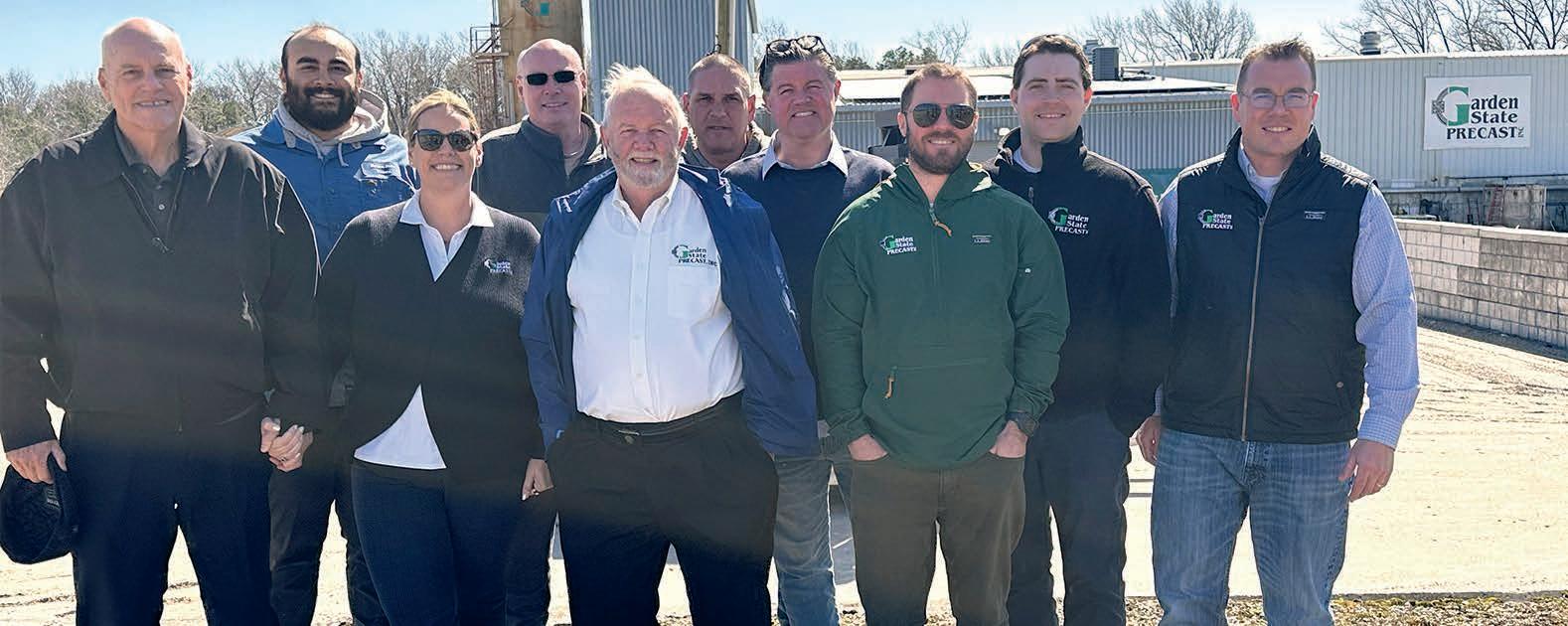











By: brian fish, account manager – Employee Benefits, IOA
For the fathers, sons, brothers, friends and co-workers. June is back and its Men’s Health Month. Have you gone for your annual wellness check? How about your father or son? Have they gone for theirs? Let this serve as your reminder; it is time to check on your boys (pun intended).
Here are a few pieces of information from the Mayo Clinic regarding the leading cause of death in men, heart disease. Just some things to keep in mind while you keep America moving; don’t forget about yourself.
Heart disease is a leading cause of death. You can't change some risk factors for it, such as family history, sex at birth or age. But you can take plenty of other steps to lower your risk of heart disease.
Get started with these eight tips to boost your heart health:
1. Don't smoke or use tobacco
One of the best things you can do for your heart is to stop smoking or using smokeless tobacco. Even if you're not a smoker, be sure to stay away from secondhand smoke.
The risk of heart disease starts to drop in as little as a day after quitting. After a year without cigarettes, the risk of heart disease drops to about half that of a smoker. No matter how long or how much you smoked, you'll start reaping rewards as soon as you quit.
2. Get moving: Aim for at least 30 to 60 minutes of activity daily
Regular, daily physical activity can lower the risk of heart disease. Physical activity helps control your weight. It also lowers the chances of getting other conditions that may put a strain on the heart. These include high blood pressure, high cholesterol and type 2 diabetes.
- 150 minutes a week of moderate aerobic exercise, such as walking at a brisk pace.
- 75 minutes a week of vigorous aerobic activity, such as running.
- Two or more strength training sessions a week.
3. Eat a heart-healthy diet
A healthy diet can help protect the heart, improve blood pressure
and cholesterol, and lower the risk of type 2 diabetes. A hearthealthy eating plan includes:
• Vegetables and fruits.
• Beans or other legumes.
• Lean meat and fish.
• Low-fat or fat-free dairy foods.
• Whole grains.
• Healthy fats such as olive oil and avocado.
4. Maintain a healthy weight
Even a small weight loss can be good for you. Reducing weight by just 3% to 5% can help lower certain fats in the blood called triglycerides and can lower blood sugar, also called glucose. Losing weight can cut the risk of type 2 diabetes and helps lower blood pressure and blood cholesterol levels.
5. Get quality sleep
People who don't get enough sleep have a higher risk of obesity, high blood pressure, heart attack, diabetes and depression.
Most adults need at least seven hours of sleep each night and children usually need more. So, make sure you get enough rest. Set a sleep schedule and stick to it. To do that, go to bed and wake up at the same time each day and keep your bedroom dark and quiet.
6. Manage stress
Ongoing stress can play a role in higher blood pressure and other risk factors for heart disease. Some people also cope with stress in unhealthy ways. For example, they may overeat, drink or smoke. You can boost your health by finding other ways to manage stress. Healthy tactics include physical activity, relaxation exercises, mindfulness, yoga and meditation.
7. Get regular health screening tests
High blood pressure and high cholesterol can damage the heart and blood vessels. But if you don't get checked for these conditions, you likely won't know whether you have them. Regular screening tests can tell you what your numbers are and whether you need to take action.
• Blood pressure. Regular blood pressure screenings usually start in childhood. Starting at age 18, blood pressure should be measured at least once every two years. This checks for high blood pressure as a risk factor for heart disease and stroke.
If you're between 18 and 39 and have risk factors for high blood pressure, you'll likely be screened once a year. People age 40 and older also are given a blood pressure test yearly.
• Cholesterol levels. The National Heart, Lung, and Blood Institute (NHLBI) recommends that cholesterol screenings start between the ages of 9 and 11. Earlier testing may be recommended if you have other risk factors, such as a family history of early-onset heart disease. After the first cholesterol test, screenings should be repeated every five years. Then the timing changes with age. The NHLBI recommends that women ages 55 to 65 and men ages 45 to 65 get screened every one to two years and people over 65 should get their cholesterol tested once a year.
• Type 2 diabetes screening. Diabetes involves ongoing high blood sugar levels and raises the chances of getting heart disease. Risk factors for diabetes include being overweight and having a family history of diabetes. If you have any of the risk factors, your health care team may recommend early screening. If not, screening is recommended to start at age 45, followed by having your blood sugar levels tested again every three years.
If you have a condition such as high cholesterol, high blood pressure or diabetes, talk with your health care team. Your doctor may prescribe medicines and recommend lifestyle changes. Make sure to take your medicines exactly as prescribed and follow a healthy-lifestyle plan.
8. Take steps to prevent infections
Certain infections may lead to heart problems. For instance, gum disease may be a risk factor for heart and blood vessel diseases. Brush and floss daily and get regular dental checkups.








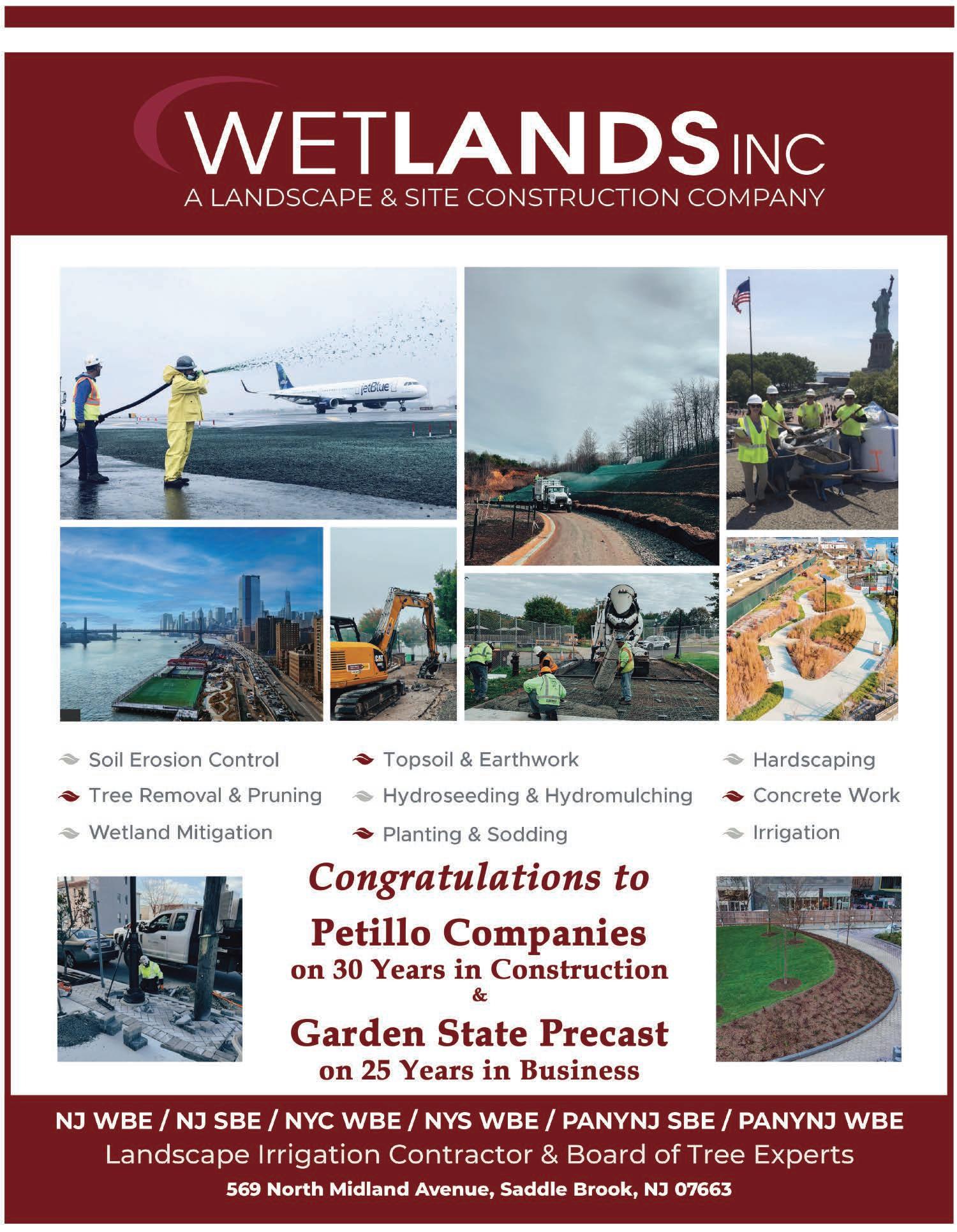




By: Ryan Sharpe
There’s an old joke that says the way to tell its summer in Ireland is that the rain is warmer. Fortunately, for this year’s Executive Seminar attendees, the rain that nourishes the green grass of the Emerald Isle mostly held off, allowing the group to take in the sights, culture, and history that can only be found in the beautiful Irish countryside.
Nearly 100 UTCA members and their families departed from Newark on April 26 for this year’s excursion to Ireland. After arriving at Shannon Airport, the group was transported to Durty Nellie’s which is dwarfed by the neighboring Bunratty Castle. Lunch and libations were enjoyed by all, thanks to our lunch sponsor Florio Perrucci Steinhardt Cappelli & Tipton.
Following lunch, attendees enjoyed a scenic bus ride through the heart of Ireland on their way to Cork’s woodlands which is home to Castlemartyr Resort. Steeped in history involving Strongbow, Sir Walter Raleigh, and the Knights Templar, Castlemartyr is a restored 18th century manor house which sits beside the remains of a an 800-year-old castle. Upon arrival guest were welcomed with traditional Irish music and cocktails at the Opening Reception, courtesy of Foley.

The next morning, the first business meeting of the trip featured an informative presentation from Agnes Antonian of Connell Foley on various environmental issues affecting the construction industry, including soil and fill recycling rules, climate change
and clean energy initiatives, clean water rules and environmental justice. Chris Colabella from Construction Information Systems (CIS) then offered a look at industry trends designed to help companies prepare for future developments in an ever-changing industry.
Soon after, many attendees embarked on a bus ride to the City of Cork while learning about the history and culture of Ireland from their knowledgeable tour guides. The group’s arrival in Cork coincided with a hurling match that gave the city a festive atmosphere as hordes of young people were in town to root on their team in its match against the squad from Clare.
Most in the group found a pub or restaurant for lunch before heading to the Midleton Distillery which is the original home of Jameson Irish Whiskey. After learning about the distilling process and the history of the property, guests took part in a tasting of various whiskeys and then headed to the bar area to do some more “tastings”.
On Monday, many attendees boarded luxury coach busses to be transported to the seaside town of Kinsale which is known for its picturesque harbor, shopping and culinary delights. Others spent the day enjoying the stunning vistas offered at Kinsale’s Old Head Golf Links which juts into the Atlantic Ocean. Other golfers stayed close to the hotel and enjoyed a round at the inland links course on the grounds of Castlemartyr Resort. Many delicious meals and cocktails were enjoyed at all hours of the day at the resort’s restaurants, the Clubhouse and at local pubs, like the Hunted Hog.
The following day the group departed Castlemartyr for the next leg of their Irish adventure which would take place in County Limerick. Along the way, a stop was made at Blarney Castle where many attendees trekked to the top of the castle tower to kiss the Blarney Stone which is said to bestow the gift of eloquence. After lunch in Blarney, the group headed to their home for the next few days: Adare Manor.
A restored manor house dating back to the 17th century, Adare Manor was nothing short of magnificent. Upon arrival, guests were treated to a horse and hounds escort as staff offered champagne and Guinness with the UTCA logo imprinted in the foam to the thirsty travelers, which were provided courtesy of our reception sponsor, Foley.
Guests at Adare Manor marveled at the luxurious hotel and the incomparable beauty of the grounds, which was matched only by the hospitality of the attentive hotel staff. In addition to its lavish accommodations, guests could enjoy a workout or swim at the Padel Club or a relaxing massage at the Spa at Adare Manor. Many took part in the variety of activities offered at Adare, including archery, falconry, and carriage rides, among many others. Of course, some guests elected to play a round at the Golf Course at Adare Manor which has been selected to host the 2027 Ryder Cup.
The next day, many attendees took in the majestic views from the Cliffs of Moher, a 700-foot sheer rockface that plunges into the Atlantic Ocean. After traversing the cliffs, the group enjoyed lunch and did some shopping in the coastal village of Lahinch

which is known as one of the preeminent surfing locations in Ireland.
Thursday and Friday saw many members of the group take part in the Secret Ireland Experience in which they visited a restored castle fortification and enjoyed local Irish culture and culinary delights dating back centuries.
The final day of activities began with a business meeting which centered on navigating the New Jersey Department of Transportation’s Disadvantaged Business Enterprise (DBE) regulations. Shawn Farrell and George Pallas of Cohen Seglias Pallas Greenhall & Furman led a fascinating discussion that included recent changes to the program and provided valuable resources to help contractors comply with DBE requirements and avoid potential pitfalls.
The traditional Farewell Dinner once again marked the end of the Executive Seminar. Sponsored by Cohen Seglias Pallas Greenhall & Furman, the dinner did not disappoint as guests enjoyed cocktails and scrumptious foods while mingling in the luxurious Grand Ballroom at Adare. On departure day, flight delays gave many the opportunity to extend the fun at Shannon
Airport’s bars and restaurants while other weary travelers whiled away the hours with some quiet time.
Despite spending a few extra hours in Ireland, it was widely agreed that this trip was a wonderful experience that would not

soon be forgotten. Thank you to our Executive Seminar sponsors, Construction Information Systems, Taylor Oil Company, Brent Material, NJ Utilities Association, UCIAF, Ritacco Construction, Weston Materials, Great Western Services, Trif & Modugno and Vollers.



